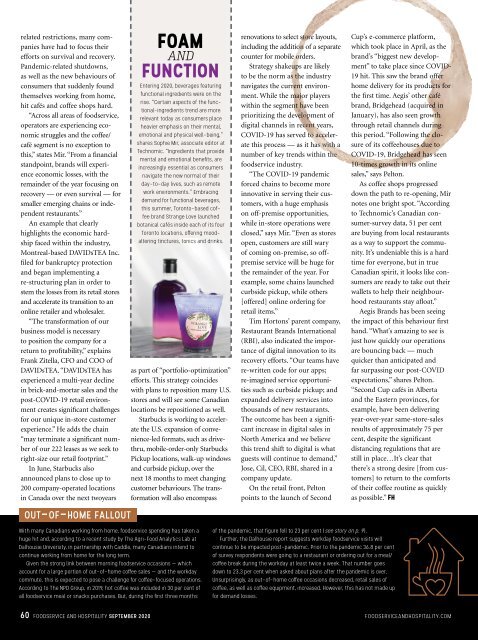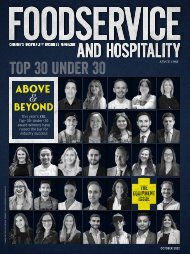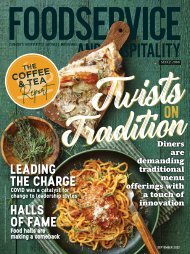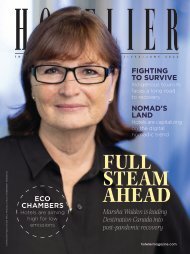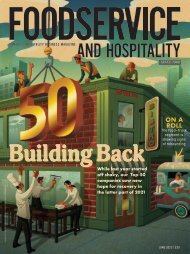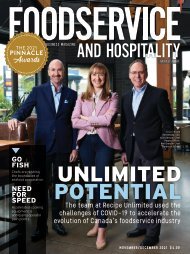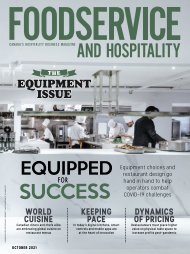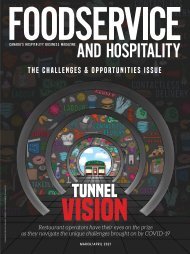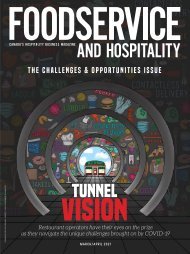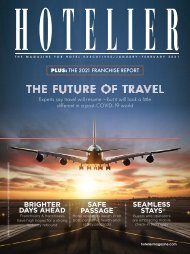September 2020
September 2020 issue of Foodservice and Hospitality magazine.
September 2020 issue of Foodservice and Hospitality magazine.
You also want an ePaper? Increase the reach of your titles
YUMPU automatically turns print PDFs into web optimized ePapers that Google loves.
elated restrictions, many companies<br />
have had to focus their<br />
efforts on survival and recovery.<br />
Pandemic-related shutdowns,<br />
as well as the new behaviours of<br />
consumers that suddenly found<br />
themselves working from home,<br />
hit cafés and coffee shops hard.<br />
“Across all areas of foodservice,<br />
operators are experiencing economic<br />
struggles and the coffee/<br />
café segment is no exception to<br />
this,” states Mir. “From a financial<br />
standpoint, brands will experience<br />
economic losses, with the<br />
remainder of the year focusing on<br />
recovery — or even survival — for<br />
smaller emerging chains or independent<br />
restaurants.”<br />
An example that clearly<br />
highlights the economic hardship<br />
faced within the industry,<br />
Montreal-based DAVIDsTEA Inc.<br />
filed for bankruptcy protection<br />
and began implementing a<br />
re-structuring plan in order to<br />
stem the losses from its retail stores<br />
and accelerate its transition to an<br />
online retailer and wholesaler.<br />
“The transformation of our<br />
business model is necessary<br />
to position the company for a<br />
return to profitability,” explains<br />
Frank Zitella, CFO and COO of<br />
DAVIDsTEA. “DAVIDsTEA has<br />
experienced a multi-year decline<br />
in brick-and-mortar sales and the<br />
post-COVID-19 retail environment<br />
creates significant challenges<br />
for our unique in-store customer<br />
experience.” He adds the chain<br />
“may terminate a significant number<br />
of our 222 leases as we seek to<br />
right-size our retail footprint.”<br />
In June, Starbucks also<br />
announced plans to close up to<br />
200 company-operated locations<br />
in Canada over the next twoyears<br />
OUT-OF-HOME FALLOUT<br />
FOAM<br />
AND<br />
FUNCTION<br />
Entering <strong>2020</strong>, beverages featuring<br />
functional ingredients were on the<br />
rise. “Certain aspects of the functional-ingredients<br />
trend are more<br />
relevant today as consumers place<br />
heavier emphasis on their mental,<br />
emotional and physical well-being,”<br />
shares Sophie Mir, associate editor at<br />
Technomic. “Ingredients that provide<br />
mental and emotional benefits, are<br />
increasingly essential as consumers<br />
navigate the new normal of their<br />
day-to-day lives, such as remote<br />
work environments.” Embracing<br />
demand for functional beverages,<br />
this summer, Toronto-based coffee<br />
brand Strange Love launched<br />
botanical cafés inside each of its four<br />
Toronto locations, offering moodaltering<br />
tinctures, tonics and drinks.<br />
as part of “portfolio-optimization”<br />
efforts. This strategy coincides<br />
with plans to reposition many U.S.<br />
stores and will see some Canadian<br />
locations be repositioned as well.<br />
Starbucks is working to accelerate<br />
the U.S. expansion of convenience-led<br />
formats, such as drivethru,<br />
mobile-order-only Starbucks<br />
Pickup locations, walk-up windows<br />
and curbside pickup, over the<br />
next 18 months to meet changing<br />
customer behaviours. The transformation<br />
will also encompass<br />
renovations to select store layouts,<br />
including the addition of a separate<br />
counter for mobile orders.<br />
Strategy shakeups are likely<br />
to be the norm as the industry<br />
navigates the current environment.<br />
While the major players<br />
within the segment have been<br />
prioritizing the development of<br />
digital channels in recent years,<br />
COVID-19 has served to accelerate<br />
this process — as it has with a<br />
number of key trends within the<br />
foodservice industry.<br />
“The COVID-19 pandemic<br />
forced chains to become more<br />
innovative in serving their customers,<br />
with a huge emphasis<br />
on off-premise opportunities,<br />
while in-store operations were<br />
closed,” says Mir. “Even as stores<br />
open, customers are still wary<br />
of coming on-premise, so offpremise<br />
service will be huge for<br />
the remainder of the year. For<br />
example, some chains launched<br />
curbside pickup, while others<br />
[offered] online ordering for<br />
retail items.”<br />
Tim Hortons’ parent company,<br />
Restaurant Brands International<br />
(RBI), also indicated the importance<br />
of digital innovation to its<br />
recovery efforts. “Our teams have<br />
re-written code for our apps;<br />
re-imagined service opportunities<br />
such as curbside pickup; and<br />
expanded delivery services into<br />
thousands of new restaurants.<br />
The outcome has been a significant<br />
increase in digital sales in<br />
North America and we believe<br />
this trend shift to digital is what<br />
guests will continue to demand,”<br />
Jose, Cil, CEO, RBI, shared in a<br />
company update.<br />
On the retail front, Pelton<br />
points to the launch of Second<br />
Cup’s e-commerce platform,<br />
which took place in April, as the<br />
brand’s “biggest new development”<br />
to take place since COVID-<br />
19 hit. This saw the brand offer<br />
home delivery for its products for<br />
the first time. Aegis’ other café<br />
brand, Bridgehead (acquired in<br />
January), has also seen growth<br />
through retail channels during<br />
this period. “Following the closure<br />
of its coffeehouses due to<br />
COVID-19, Bridgehead has seen<br />
10-times growth in its online<br />
sales,” says Pelton.<br />
As coffee shops progressed<br />
down the path to re-opening, Mir<br />
notes one bright spot. “According<br />
to Technomic’s Canadian consumer-survey<br />
data, 51 per cent<br />
are buying from local restaurants<br />
as a way to support the community.<br />
It’s undeniable this is a hard<br />
time for everyone, but in true<br />
Canadian spirit, it looks like consumers<br />
are ready to take out their<br />
wallets to help their neighbourhood<br />
restaurants stay afloat.”<br />
Aegis Brands has been seeing<br />
the impact of this behaviour first<br />
hand. “What’s amazing to see is<br />
just how quickly our operations<br />
are bouncing back — much<br />
quicker than anticipated and<br />
far surpassing our post-COVID<br />
expectations,” shares Pelton.<br />
“Second Cup cafés in Alberta<br />
and the Eastern provinces, for<br />
example, have been delivering<br />
year-over-year same-store-sales<br />
results of approximately 75 per<br />
cent, despite the significant<br />
distancing regulations that are<br />
still in place…It’s clear that<br />
there’s a strong desire [from customers]<br />
to return to the comforts<br />
of their coffee routine as quickly<br />
as possible.” FH<br />
With many Canadians working from home, foodservice spending has taken a<br />
huge hit and, according to a recent study by The Agri-Food Analytics Lab at<br />
Dalhousie University, in partnership with Caddle, many Canadians intend to<br />
continue working from home for the long term.<br />
Given the strong link between morning foodservice occasions — which<br />
account for a large portion of out-of-home coffee sales — and the workday<br />
commute, this is expected to pose a challenge for coffee-focused operations.<br />
According to The NPD Group, in 2019, hot coffee was included in 30 per cent of<br />
all foodservice meal or snacks purchases. But, during the first three months<br />
of the pandemic, that figure fell to 23 per cent (see story on p. 9).<br />
Further, the Dalhousie report suggests workday foodservice visits will<br />
continue to be impacted post-pandemic. Prior to the pandemic 36.8 per cent<br />
of survey respondents were going to a restaurant or ordering out for a meal/<br />
coffee break during the workday at least twice a week. That number goes<br />
down to 23.3 per cent when asked about plans after the pandemic is over.<br />
Unsurprisingly, as out-of-home coffee occasions decreased, retail sales of<br />
coffee, as well as coffee equipment, increased. However, this has not made up<br />
for demand losses.<br />
60 FOODSERVICE AND HOSPITALITY SEPTEMBER <strong>2020</strong> FOODSERVICEANDHOSPITALITY.COM


